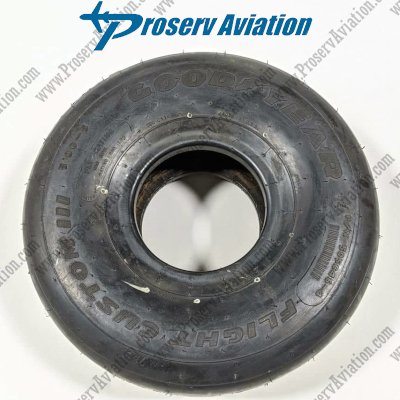Goodyear Flight Custom III 301-015-006 | 505C46-4


In Stock | Best Price | Best Service |
Goodyear Flight Custom III , 5.00 – 5, 4 Ply, 160 mph Rating, Main Landing Gear Aircraft Tire
Specifications
| Brand | Goodyear Flight Custom ||I |
| Part Number | 301-015-006 Alt# 505C46-4 |
| Size | 5.00 – 5 |
| Ply Rating | 4 PR |
| Speed Rating | 160 MPH |
| Type | TT |
| Typical Position | Main Landing Gear (MLG) |
| Typical Aircraft Application | Hawker Beechcraft Beech |
| Load Rating | 800 Lbs |
| Rated Inflation (PSI) | 31 |
Goodyear Flight Custom III Features
Aircraft tires made with Kevlar® , (pound for pound five times stronger than steel), for increased penetration resistance, reduced foreign object damage, and enhanced dimensional stability.
- Enhanced tread wear is achieved through a two-groove, square-shoulder tread shape, providing superior wet traction and resistance to hydroplaning.
Frequently Asked Questions (FAQ) — Aircraft Tires
1. What are the main types / constructions of aircraft tires?
- Bias-ply (bias) tires: Plies (fabric layers) are laid at alternating angles less than 90° to the tread centerline. These have traditionally been common in aviation. (They tend to have stiffer sidewalls and more internal shearing at high loads.)
- Radial tires: Plies are oriented approximately 90° (perpendicular) to the tread centerline, and then stabilized with circumferential belts. Radials often provide better heat dissipation and more uniform wear.
- Also, tires may be tube-type (with an inner tube) or tubeless (with a built-in inner liner to retain gas).
2. How often should tire pressure be checked?
- Tire pressure should be checked daily or before first flight, when the tires are cold (at ambient temperature).
- Aircraft tire assemblies can lose up to 5% of inflation pressure in 24 hours and still be considered within a normal range. (
- Use dry nitrogen when possible (less reactive, more stable) for inflation.
- Be aware of temperature effects: a change of ~3 °C (5 °F) corresponds to ~1% pressure change.
3. What are the criteria for removing a tire from service?
Tires should be removed whenever they show signs that compromise safety or performance. Some common removal criteria:
- Tread worn down to the base of any groove, or to the minimum depth specified by the manufacturer.
- Cracks, cuts, or groove cracking that expose internal fabric / structural plies or undercut tread ribs.
- Sidewall damage (cuts, cracks) that penetrate down to the structural plies.
- Internal separations, bulging, distortions in the casing, or evidence of heat damage or slipping (e.g. rubber reversion).
- Deep flat spots or vibration problems that cannot be corrected by balancing.
The specific wording and threshold recommendations are covered in FAA Advisory Circular AC 20-97B §7 (Tire removal & in-service inspections) and in manufacturer manuals.
4. Can aircraft tires be balanced like car tires?
Yes — balancing an aircraft tire/wheel assembly is a beneficial practice (though not always practiced):
- Balancing helps reduce vibration, gear component wear, and uneven tire wear.
- The standard practice is to align the red dot (light spot) on the tire with the valve stem (heavy point) before mounting.
- Dynamic balancing (spin-balancing) of the tire + wheel is ideal, but many aviation shops lack this capability.
5. How does heat affect aircraft tires, and how is it managed?
- Heat is one of the major stressors for aircraft tires, especially during high-speed operations and heavy braking.
- High heat can degrade rubber (reversion), weaken bond interfaces, cause internal separation, or accelerate aging.
- To mitigate heat:
- Use compounds and reinforcing materials that resist high temperature degradation.
- Use radial construction for improved heat dissipation.
- Maintain correct inflation to reduce internal flexing and hysteresis heating.
- Limit extended high-speed taxi or braking whenever possible.
- In storage, keep tires in a cool, dry environment (away from ozone, UV, chemicals).
- Use compounds and reinforcing materials that resist high temperature degradation.
6. Does tire age matter?
- Age on its own is not always a disqualifier, provided the tire continues to meet inspection, visual, and inflation criteria.
- However, many operators rotate inventory (FIFO) to avoid excessively old tires in use.
- Stored assemblies (mounted + inflated) may need re-inspection after long intervals (e.g. after 12 months).
7. What are some best practices for tire handling, mounting, and storage?
- Store tires in a cool, dry place away from direct sunlight, ozone sources (e.g., electric motors), fuel/oil/hydraulic fluids.
- Store tires vertically or flat (per manufacturer guidance) to avoid distortion.
- When mounting/demounting, use proper tools, follow procedures, use safety cages (because of explosion risk), and allow cooling before deflating.
- Inflate new assemblies and allow a “stretch” period (often ~12 hours) before full use, then re-check pressure.
- After mounting, perform a 24-hour pressure retention check to verify no leaks.
- Avoid stacking or hanging tubes over pegs or sharp edges.
